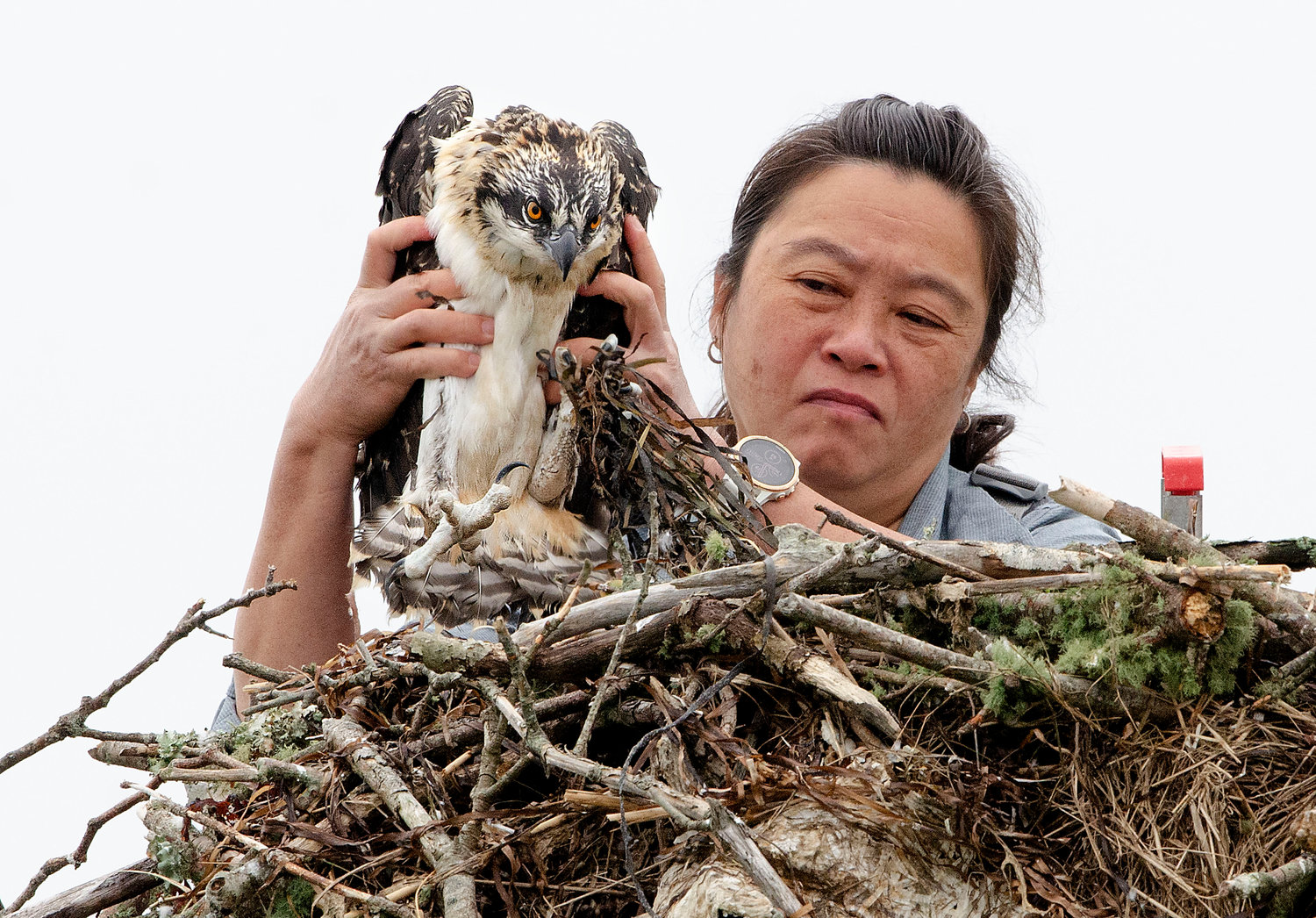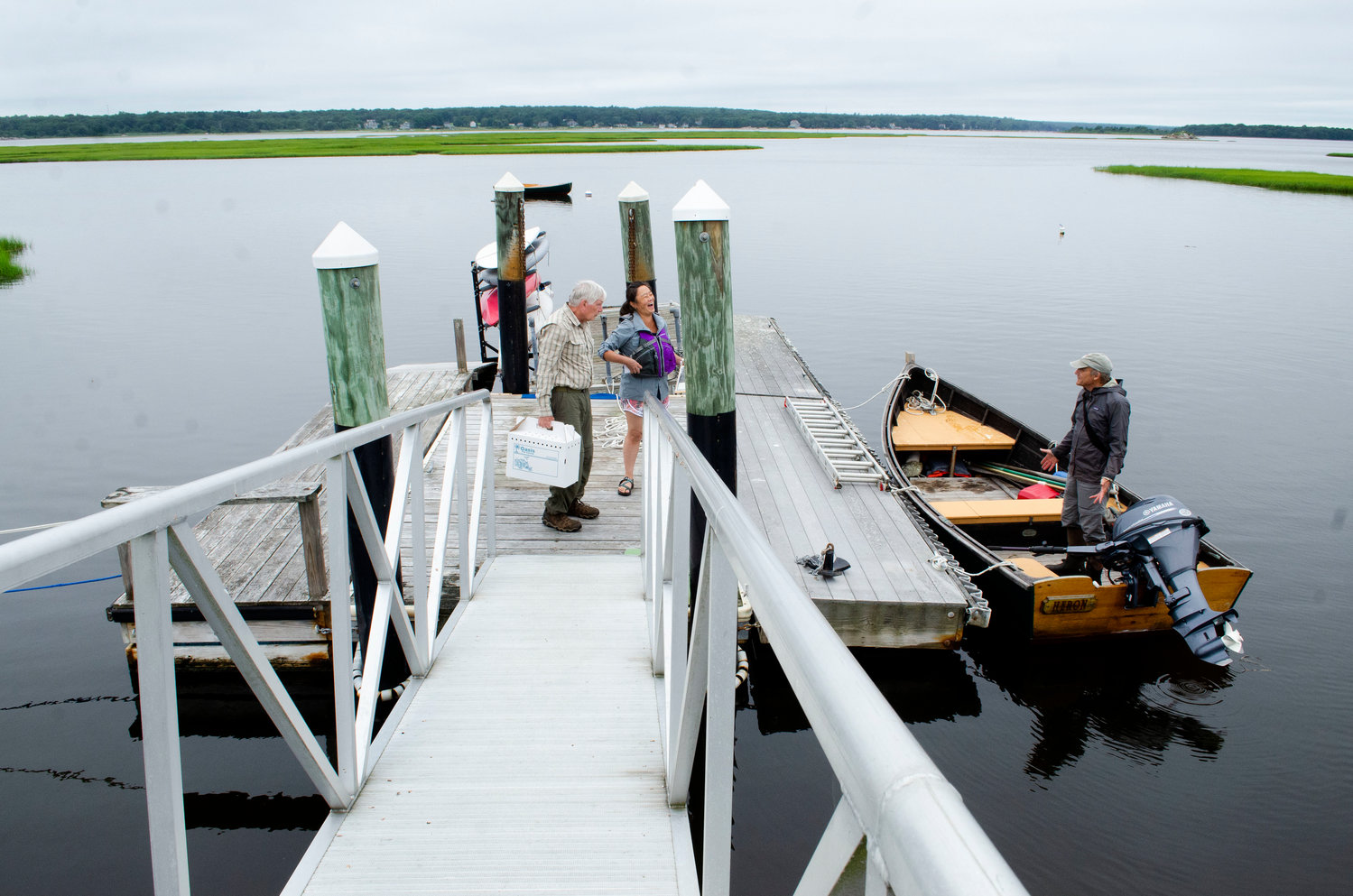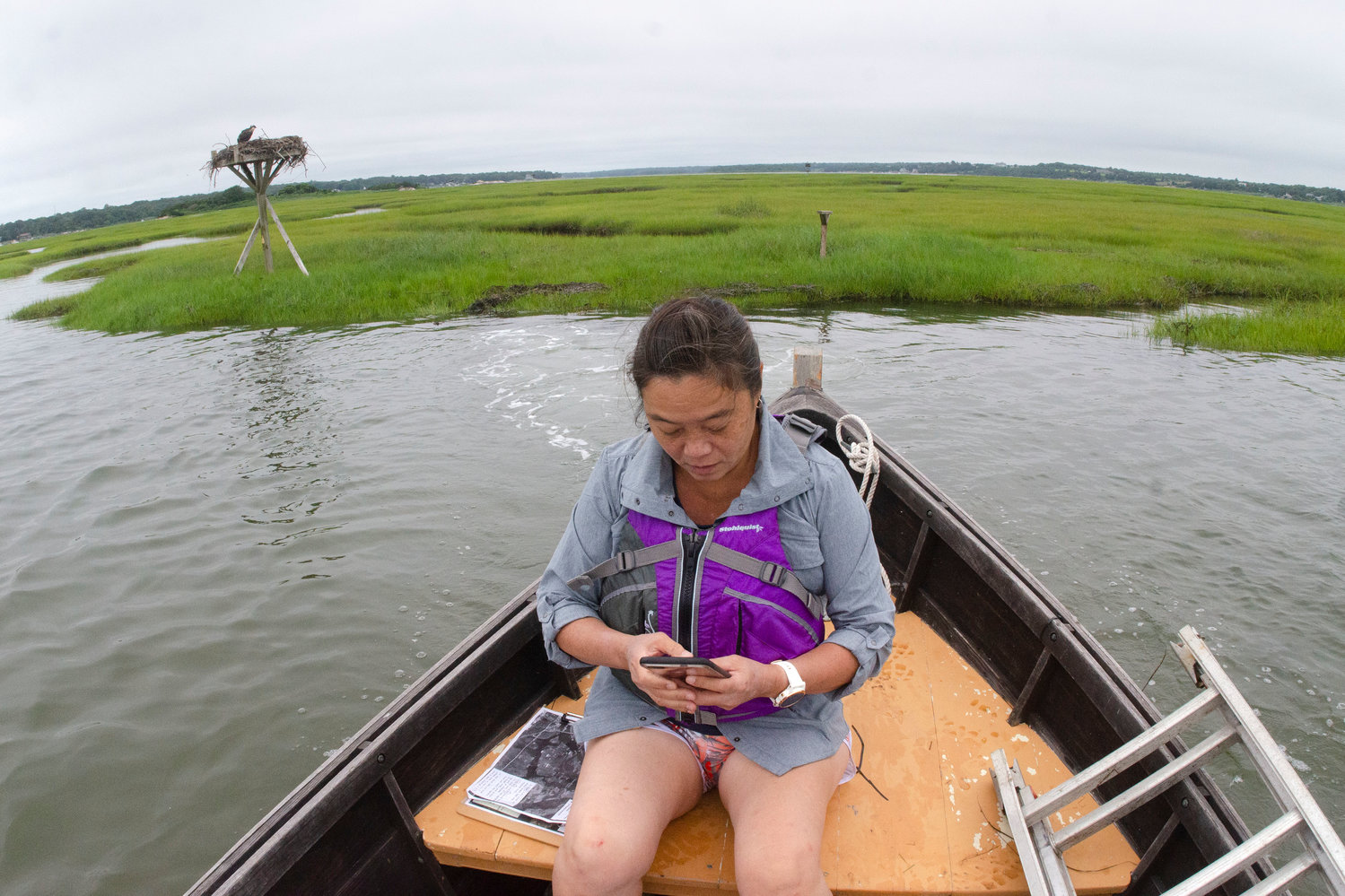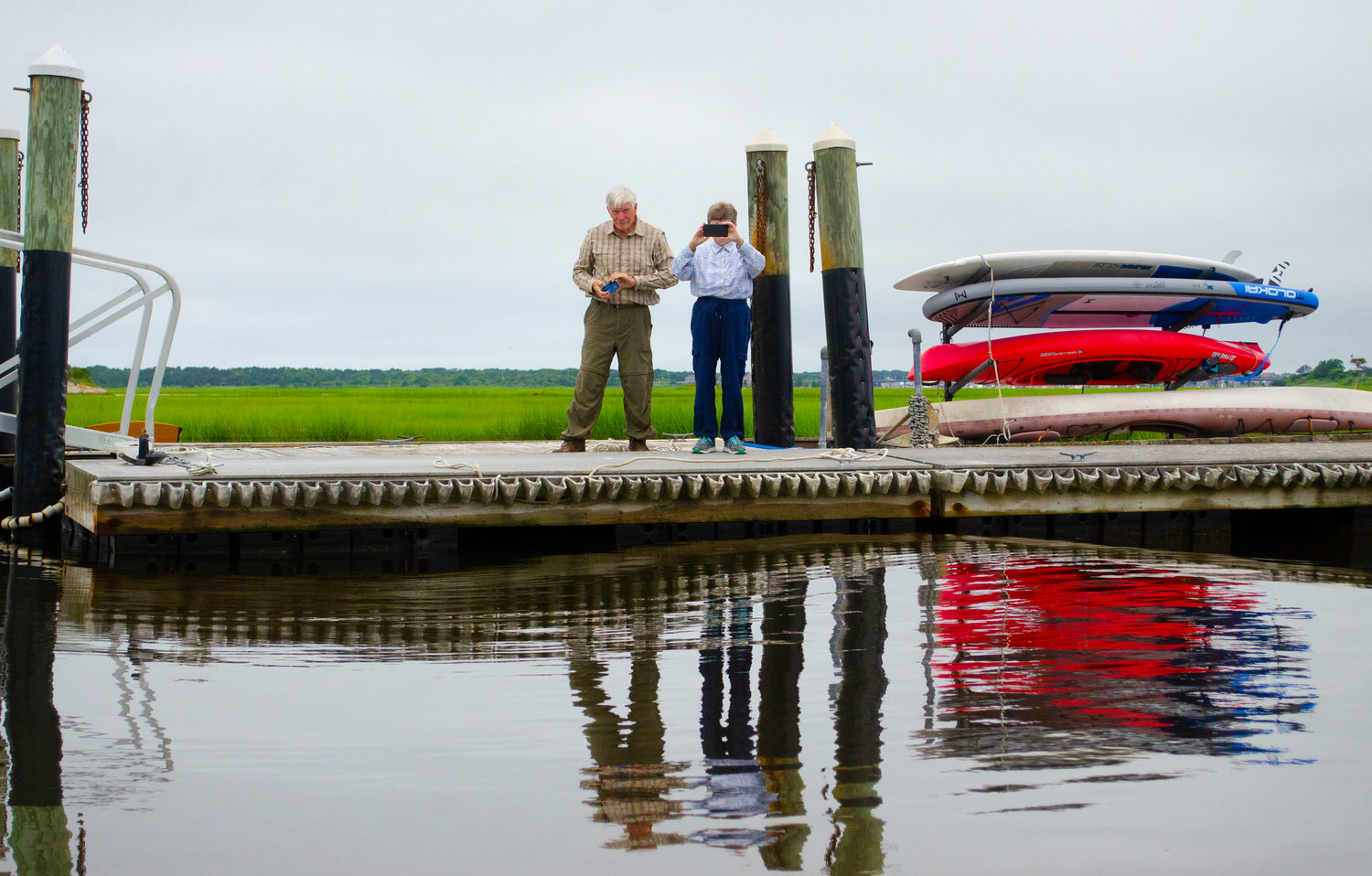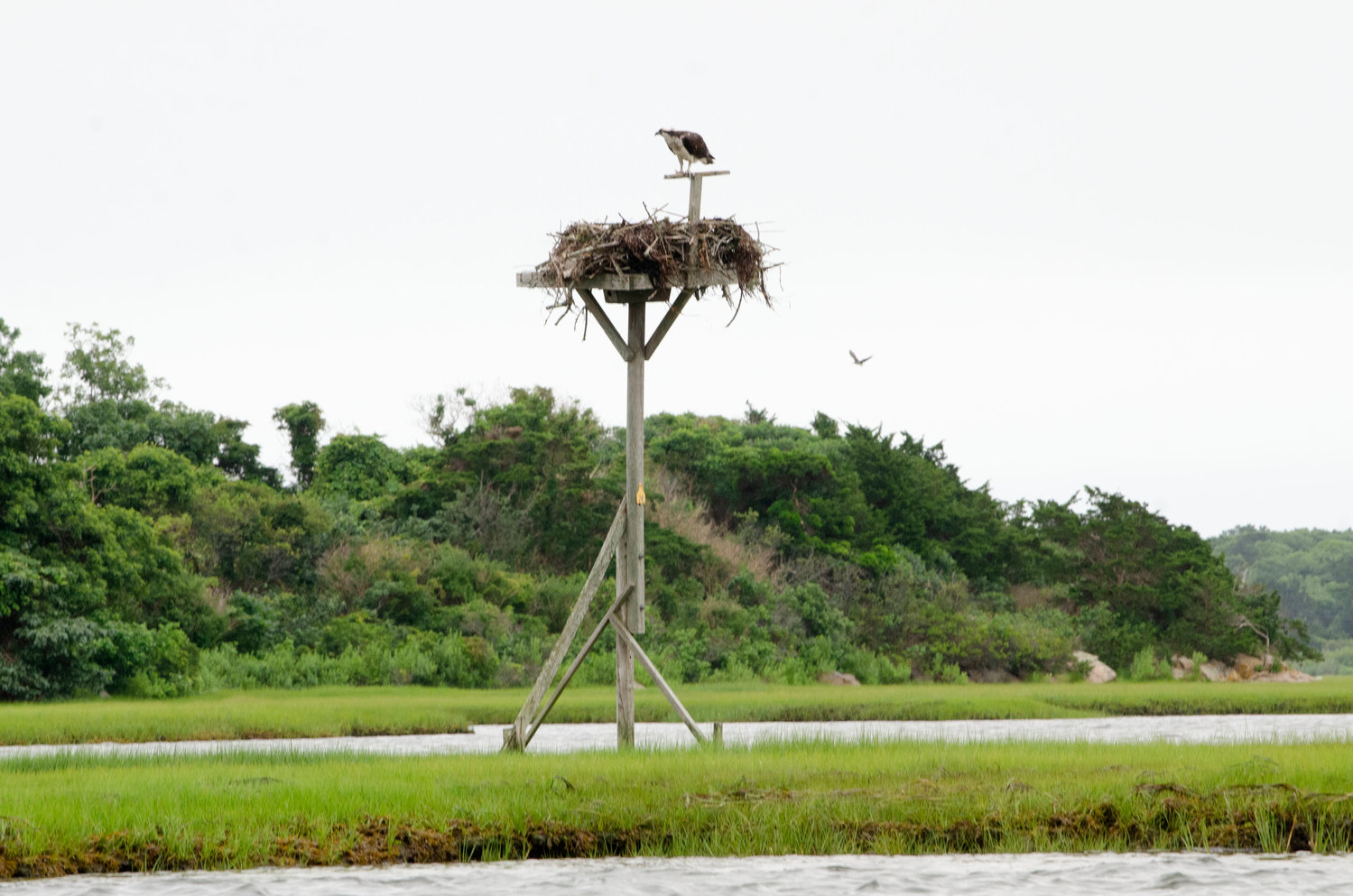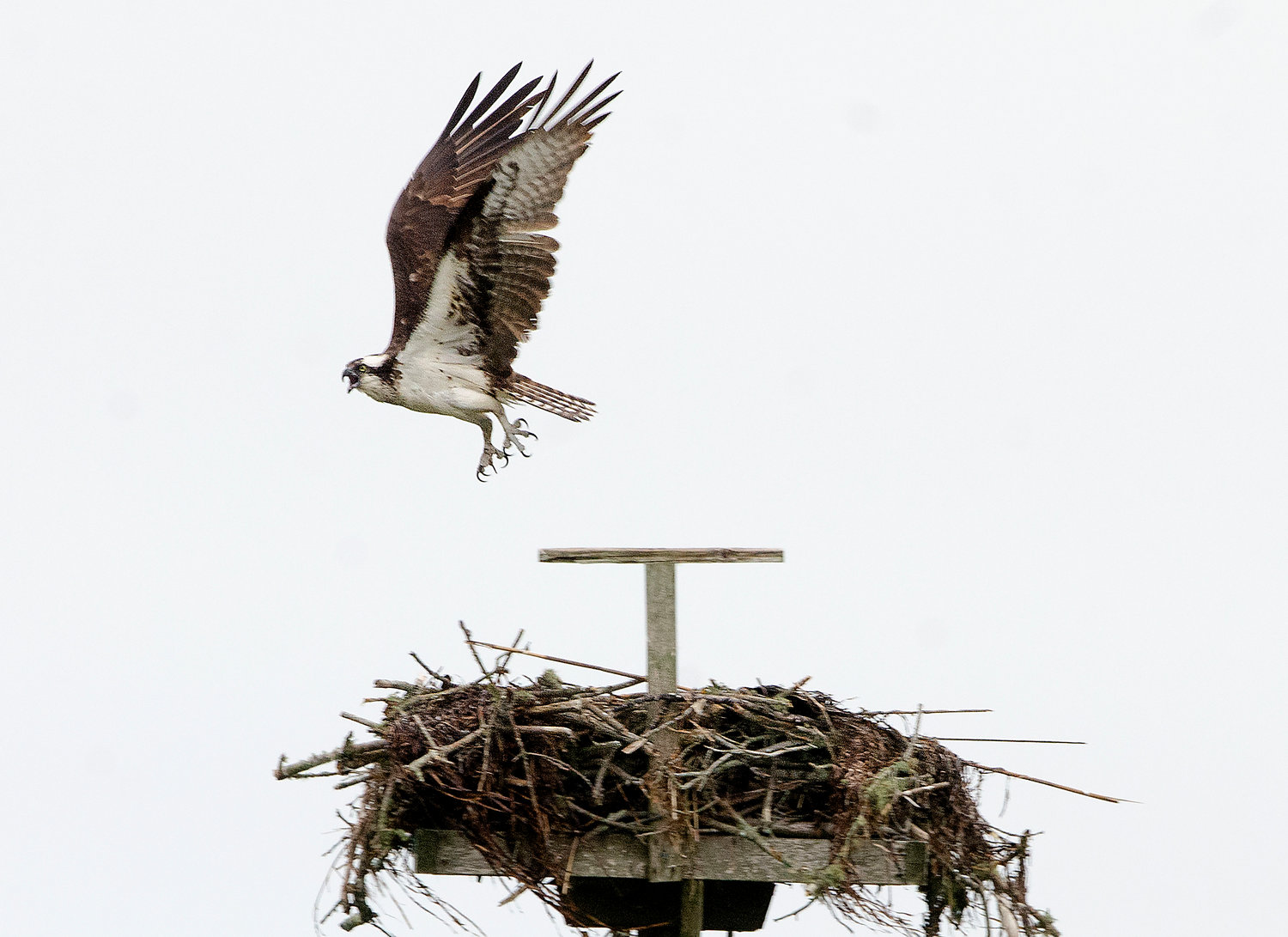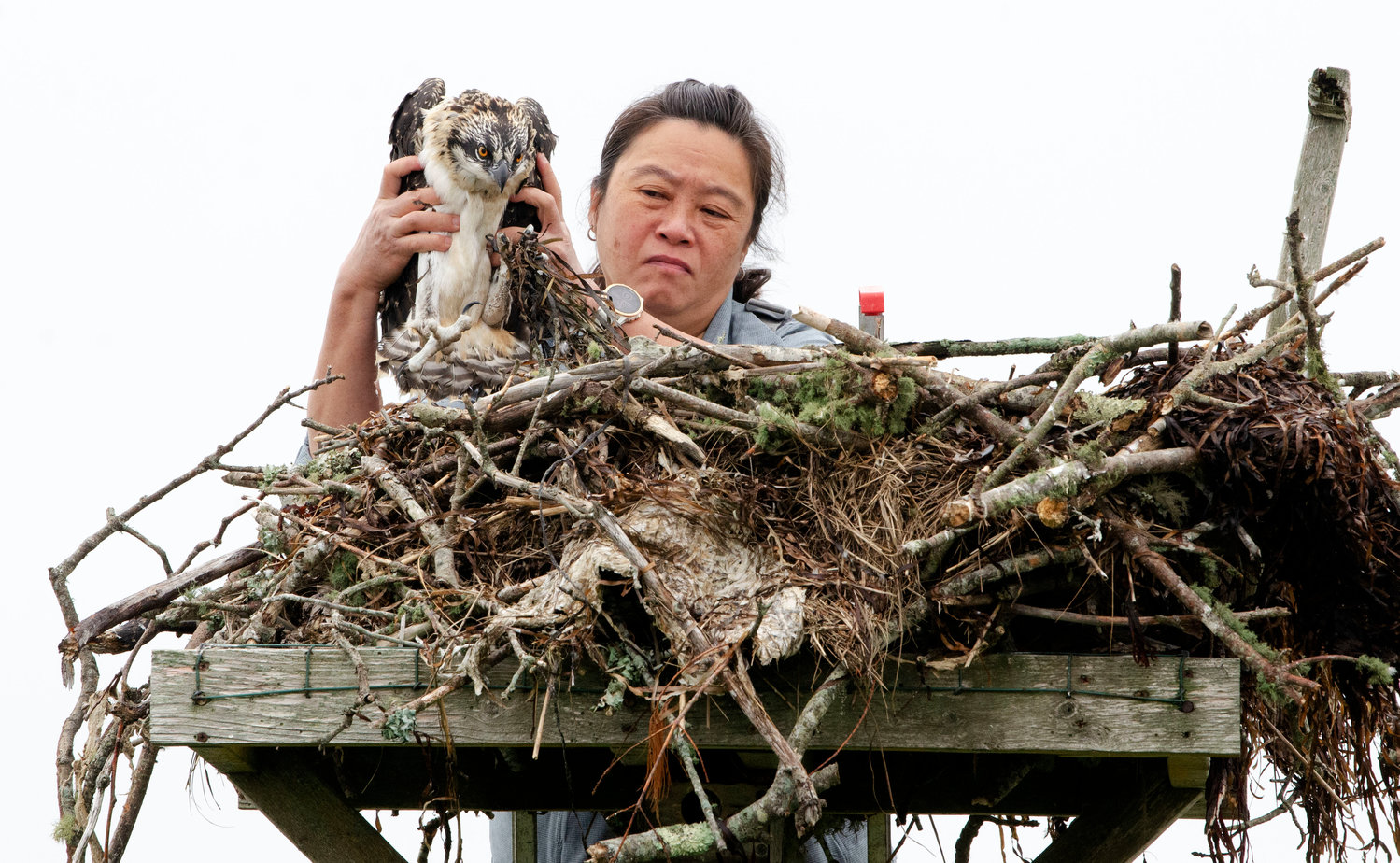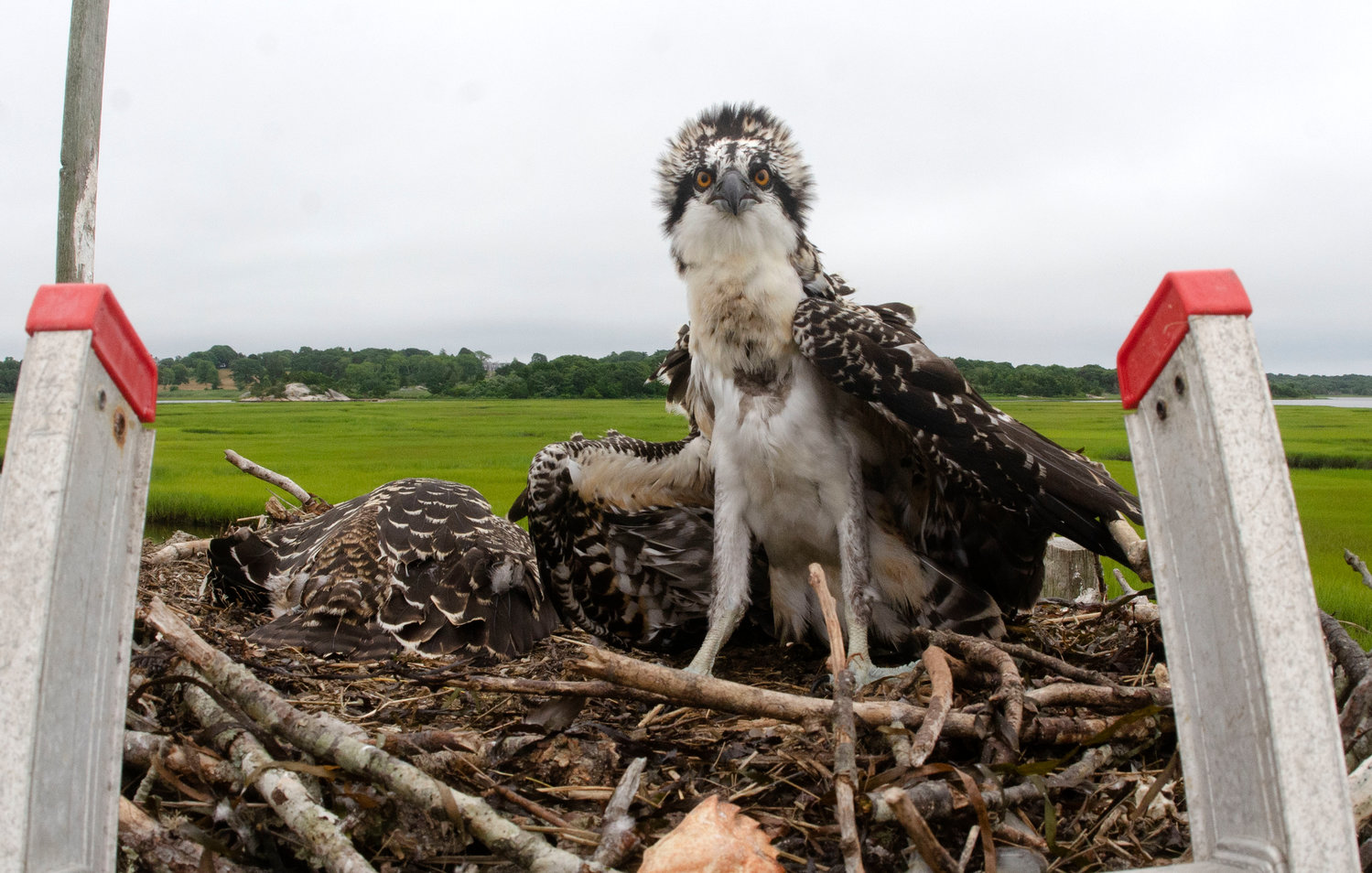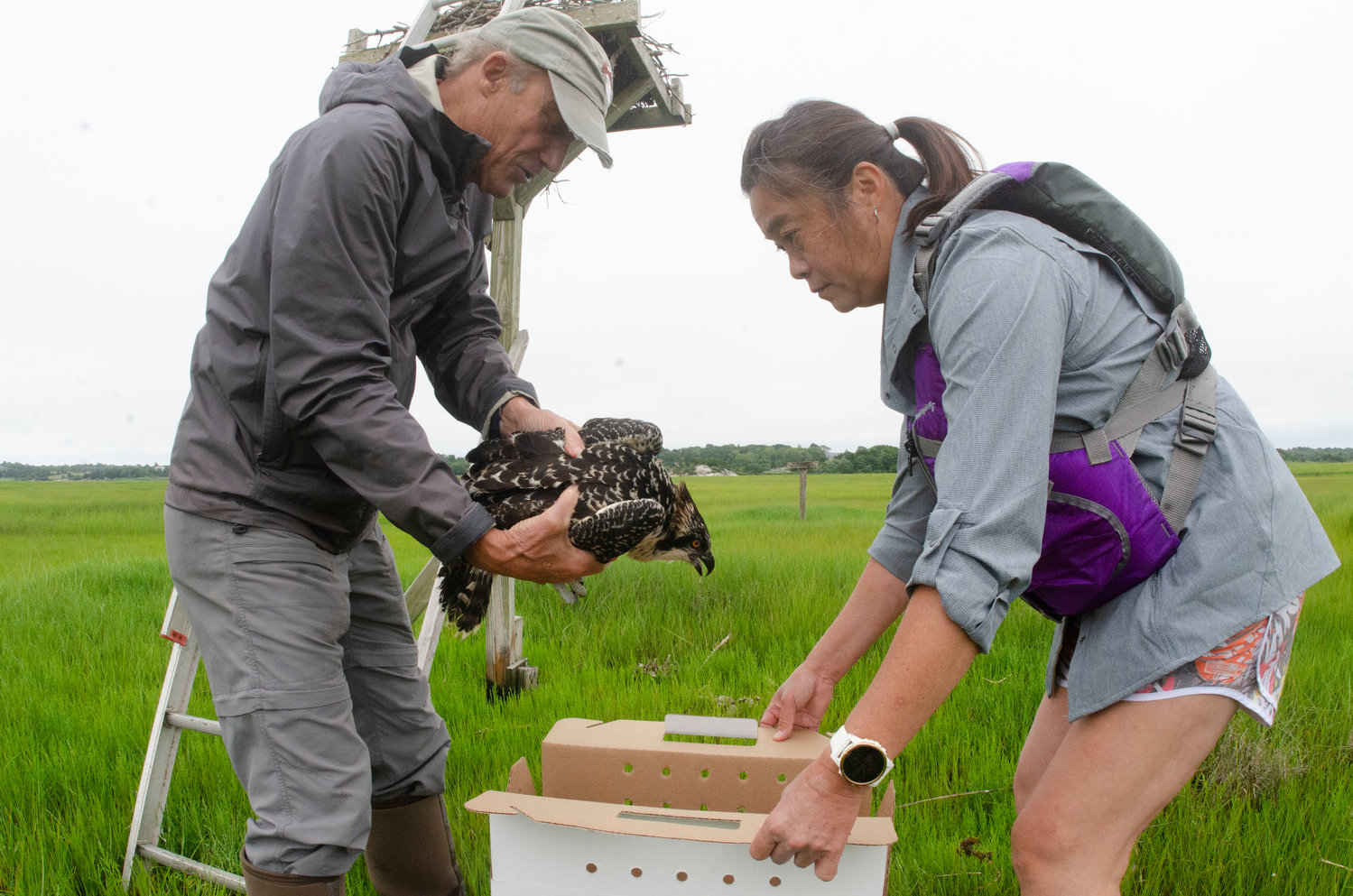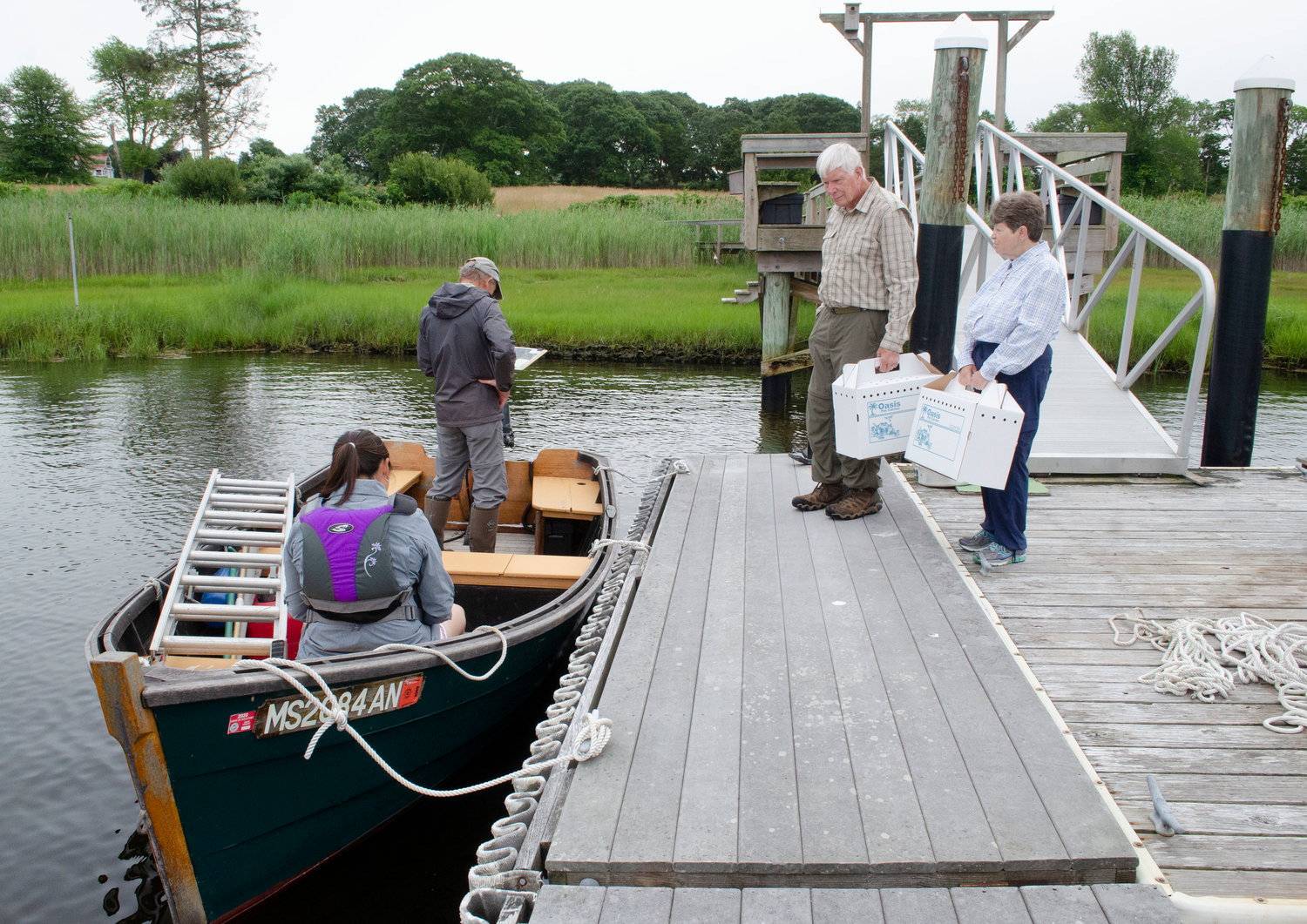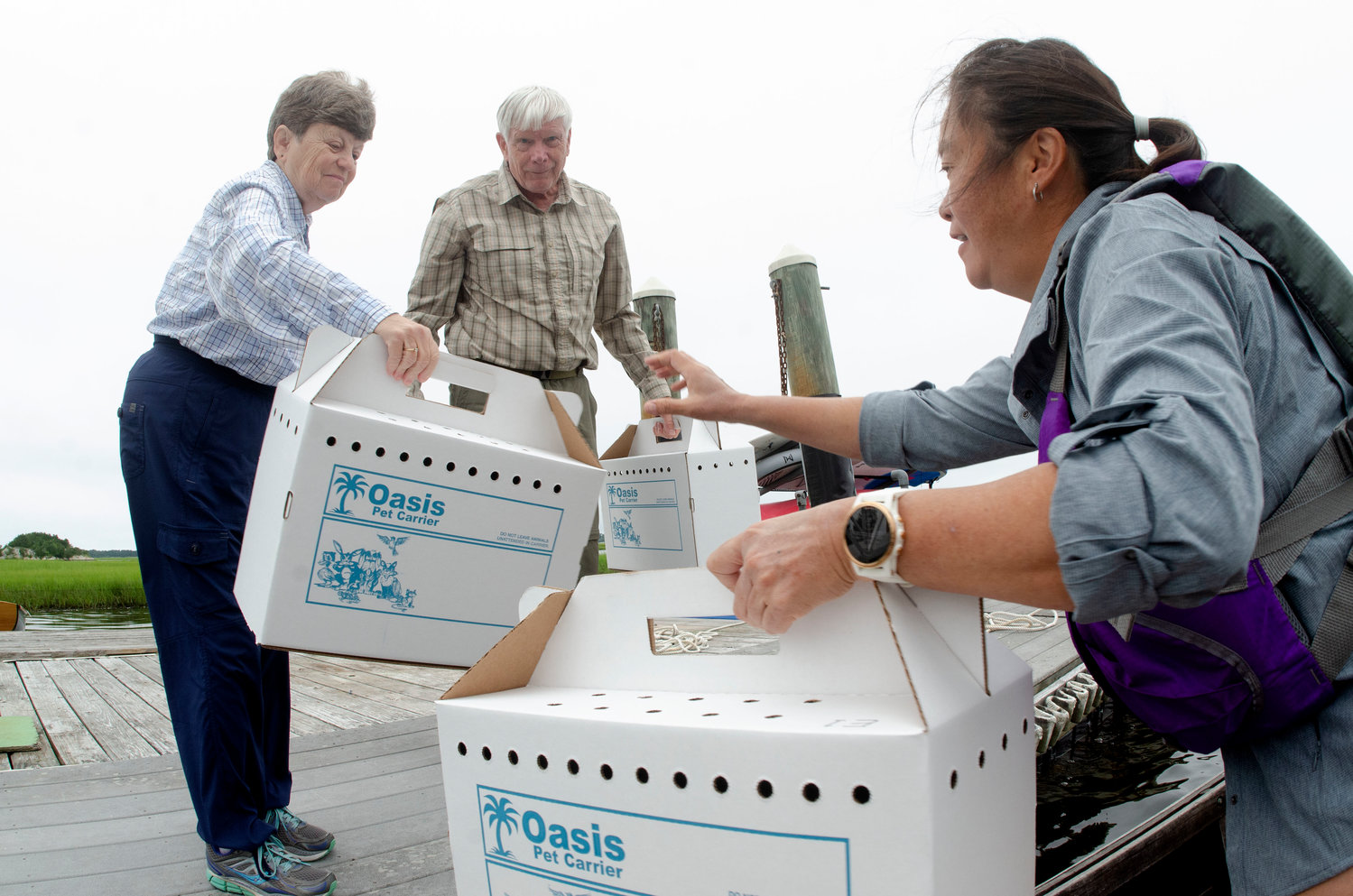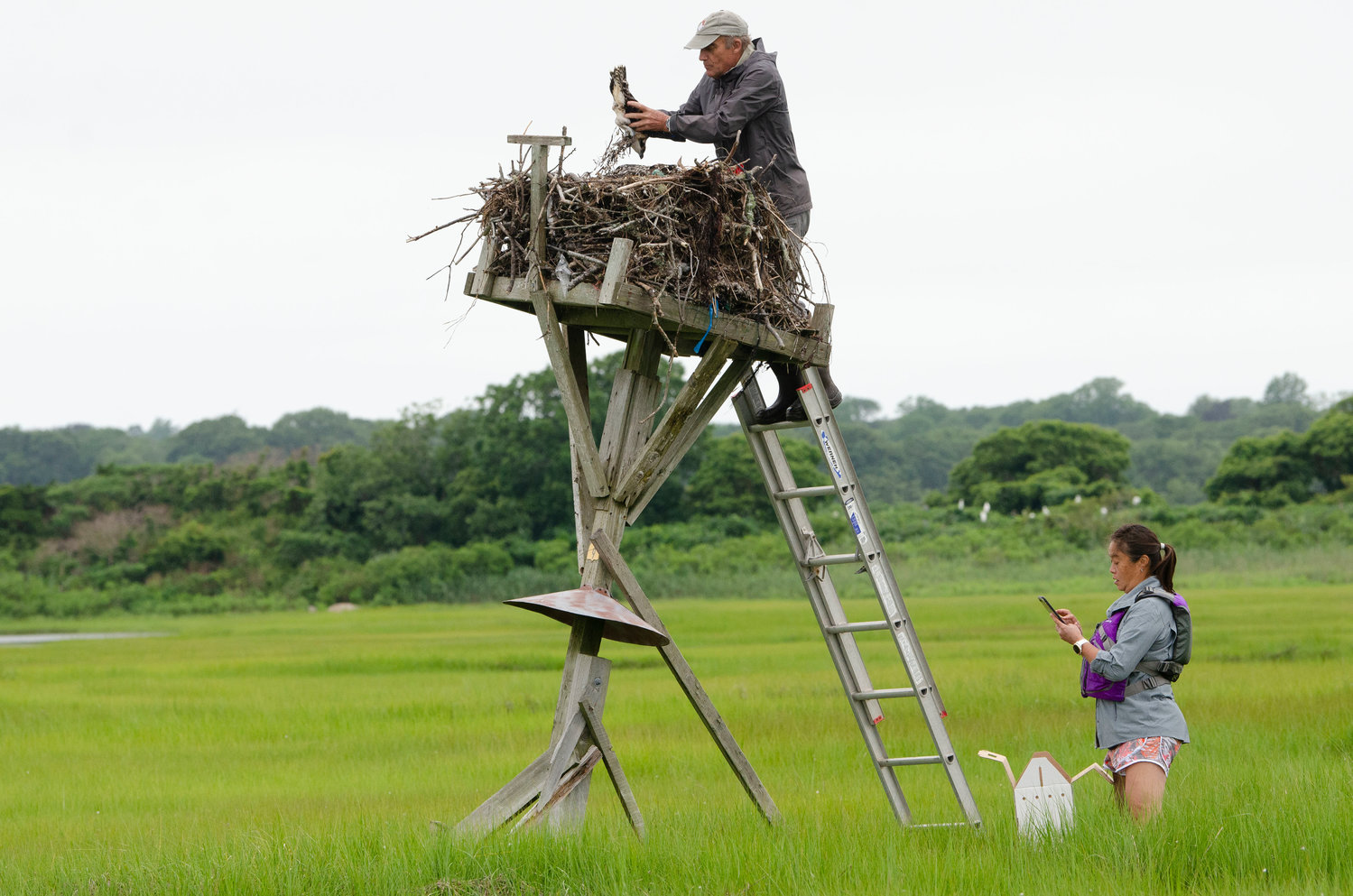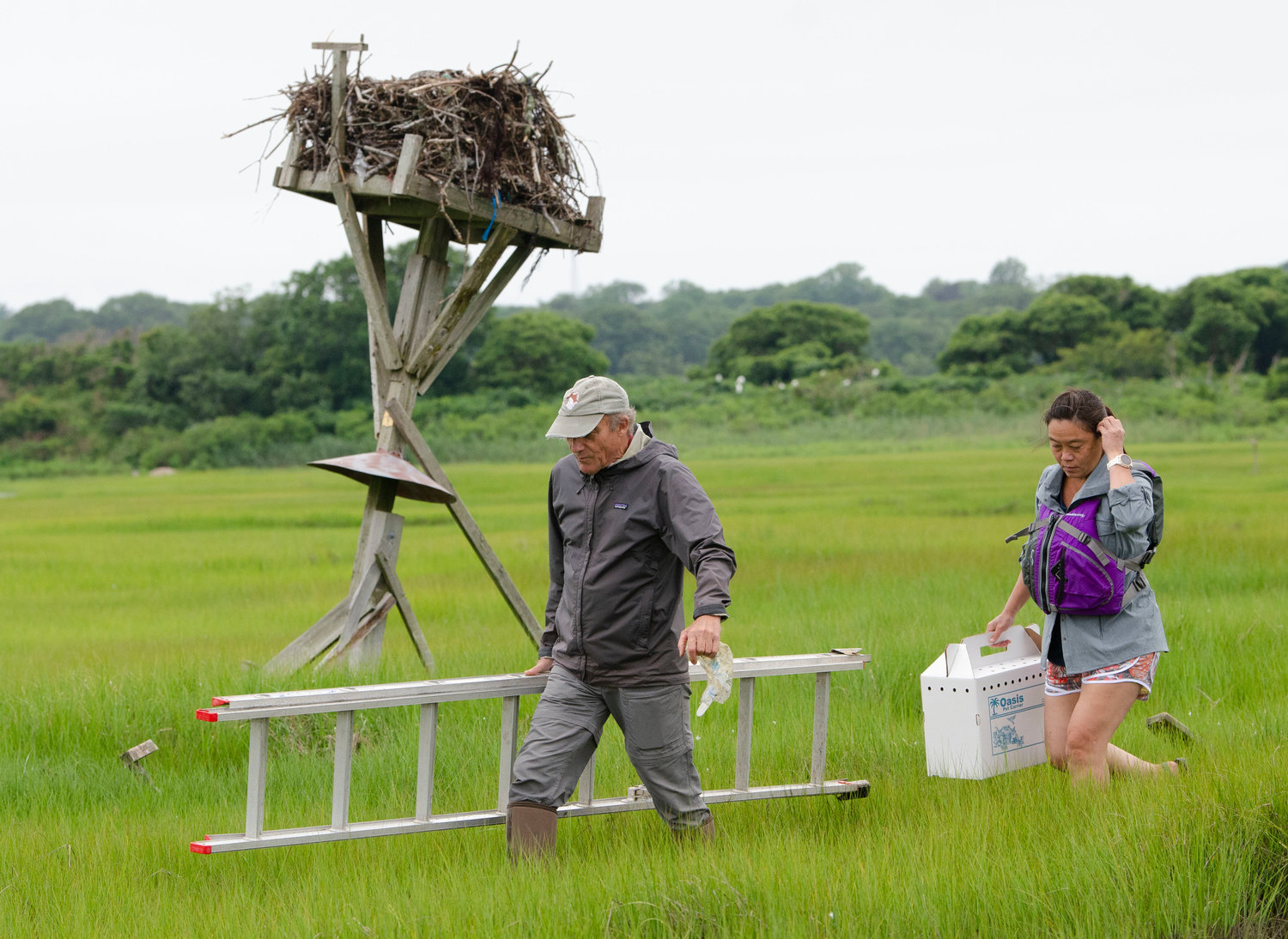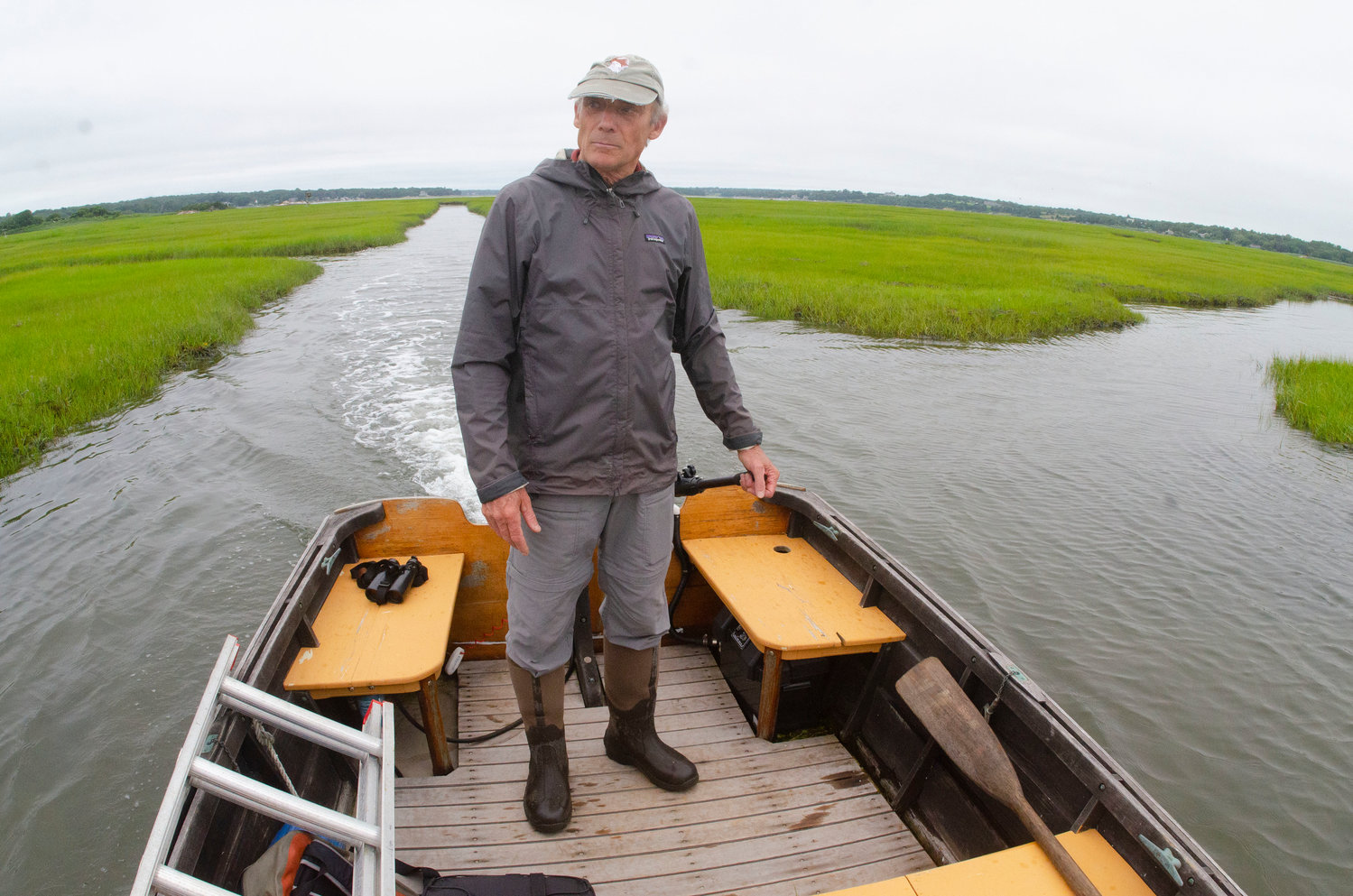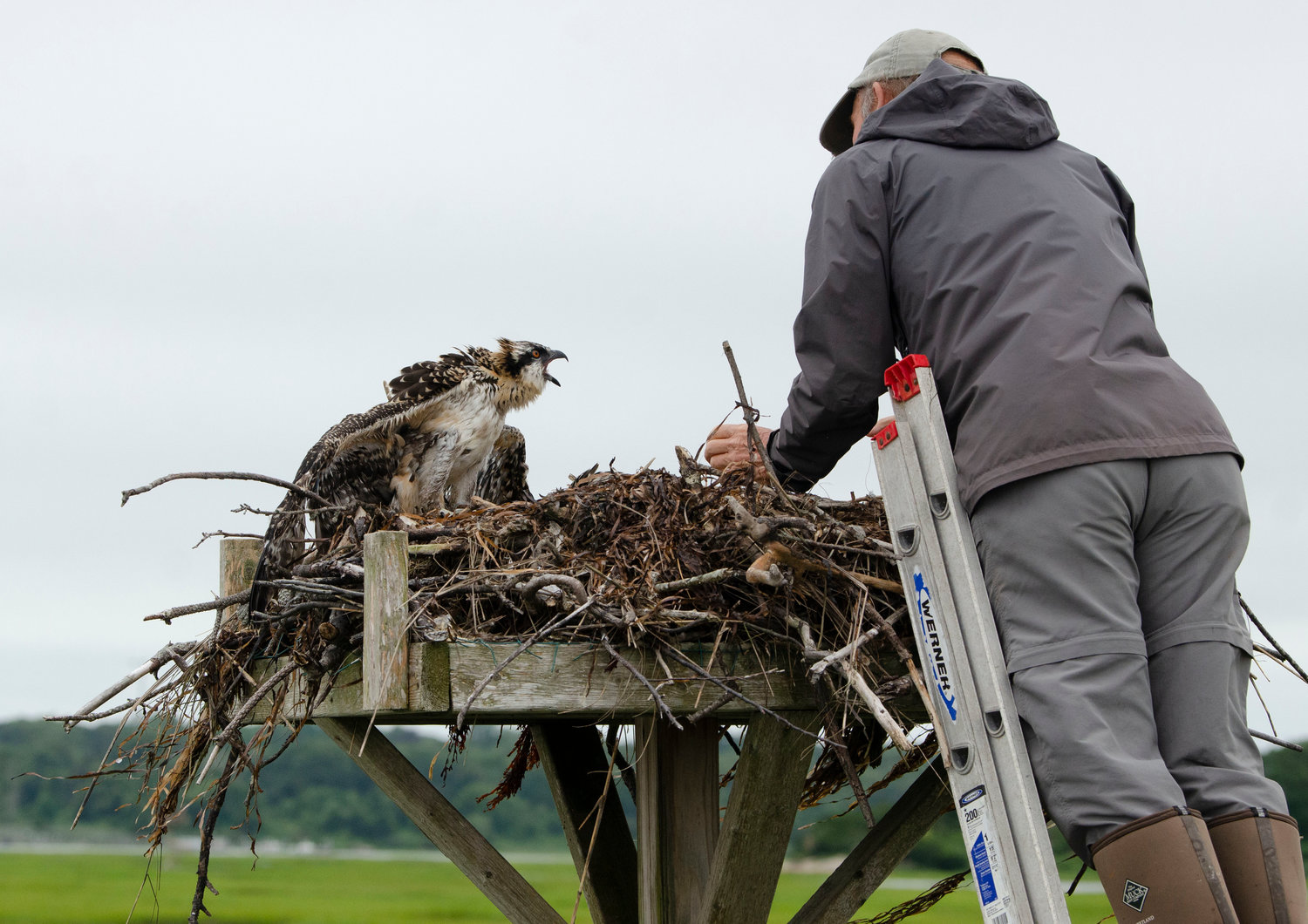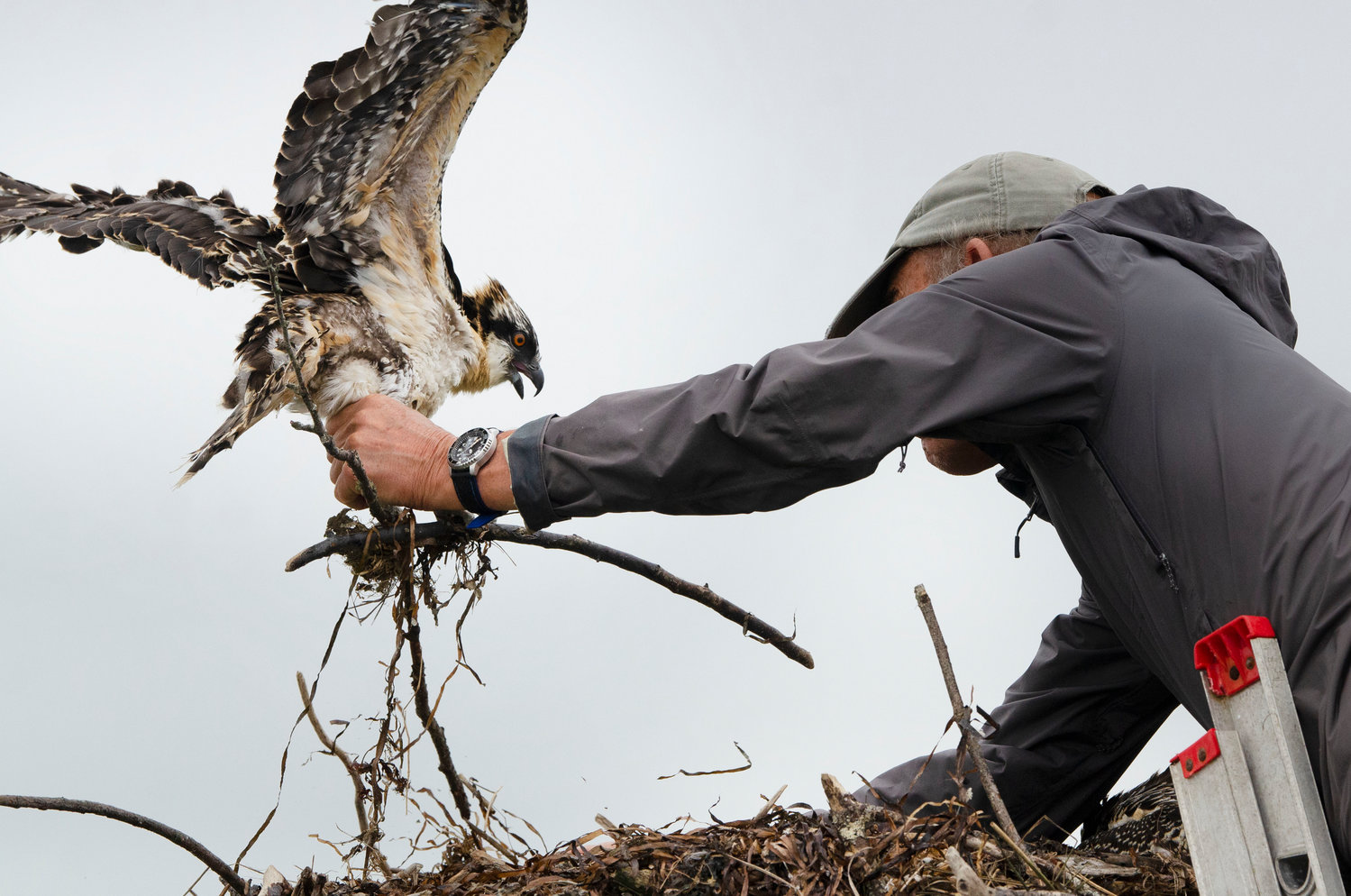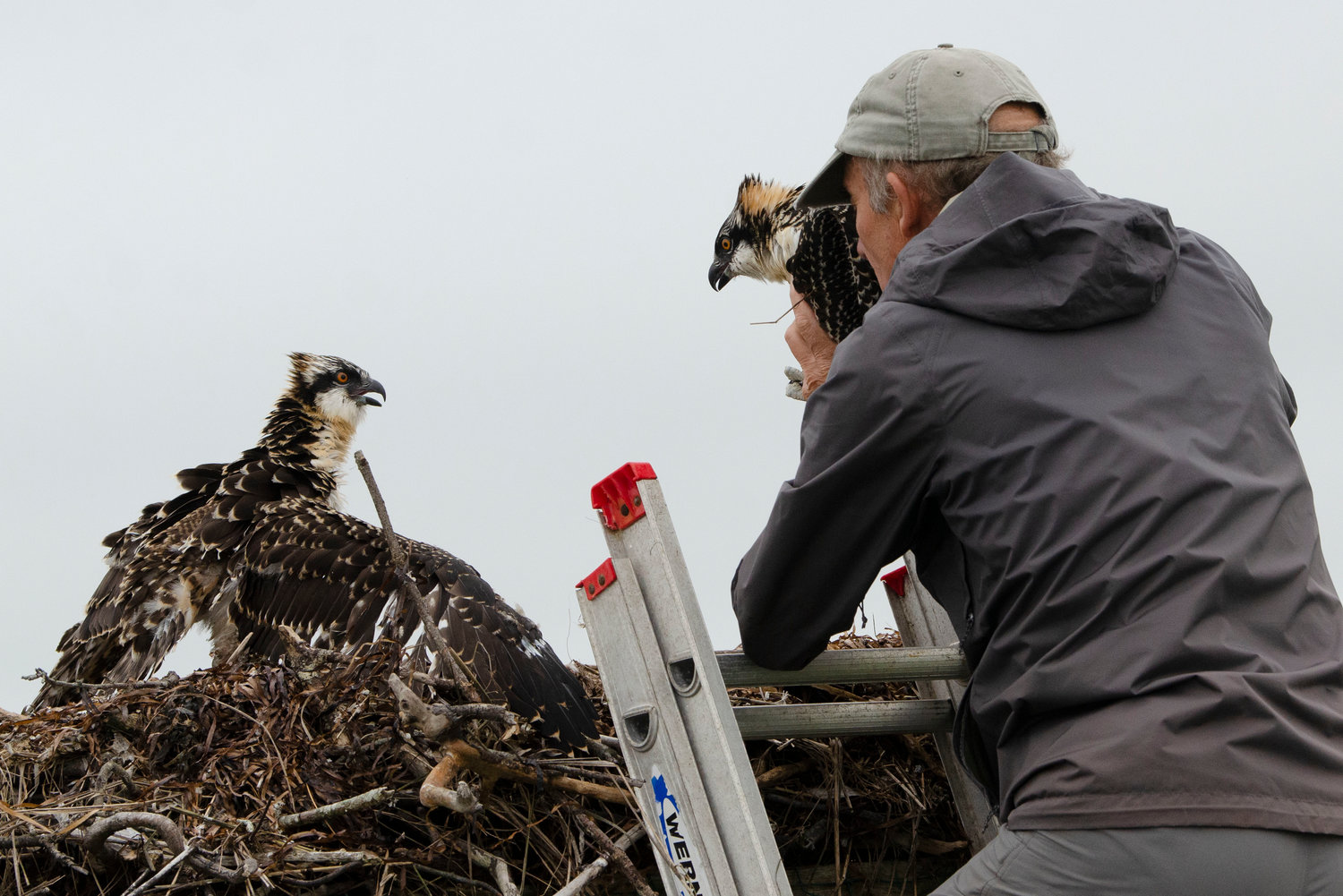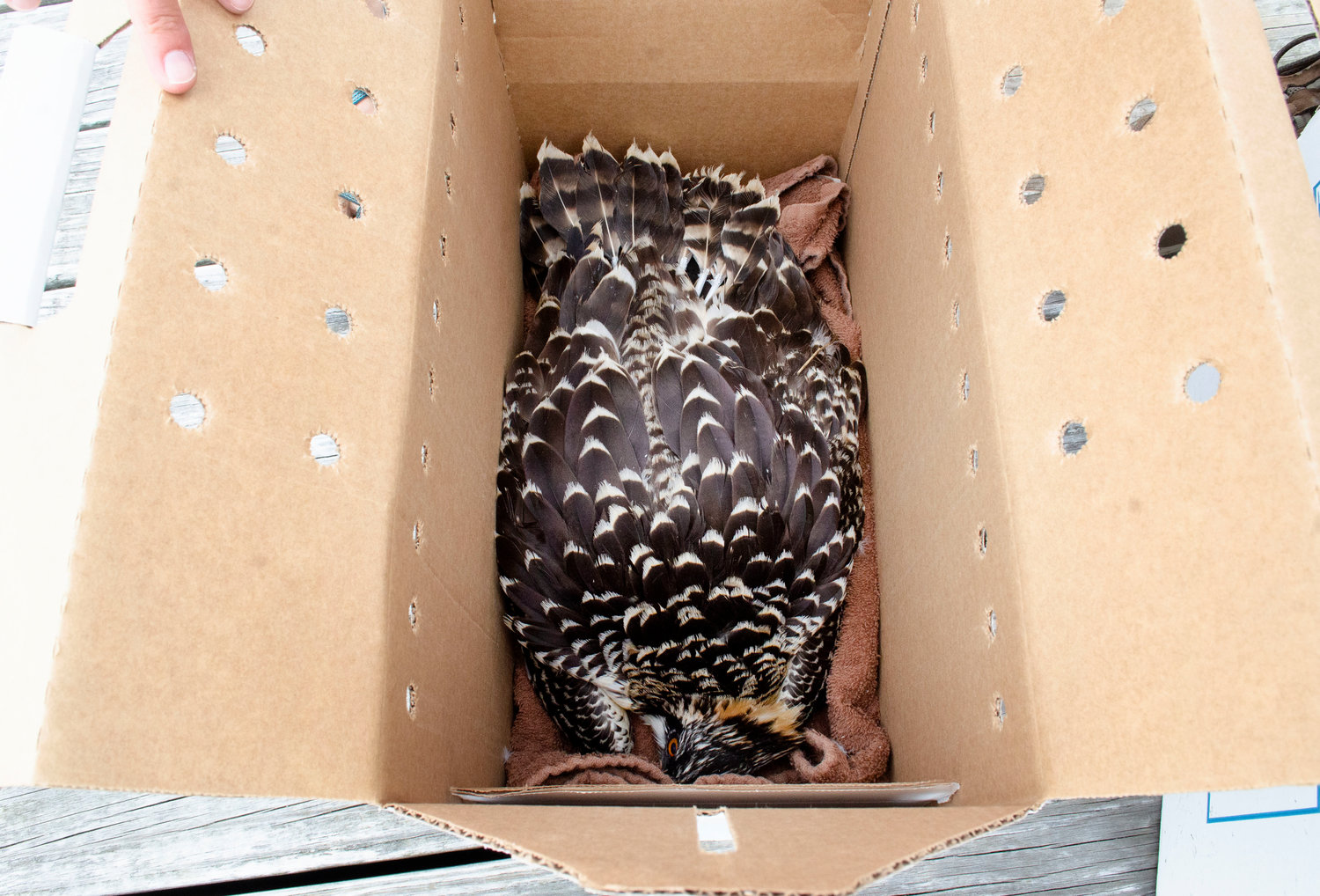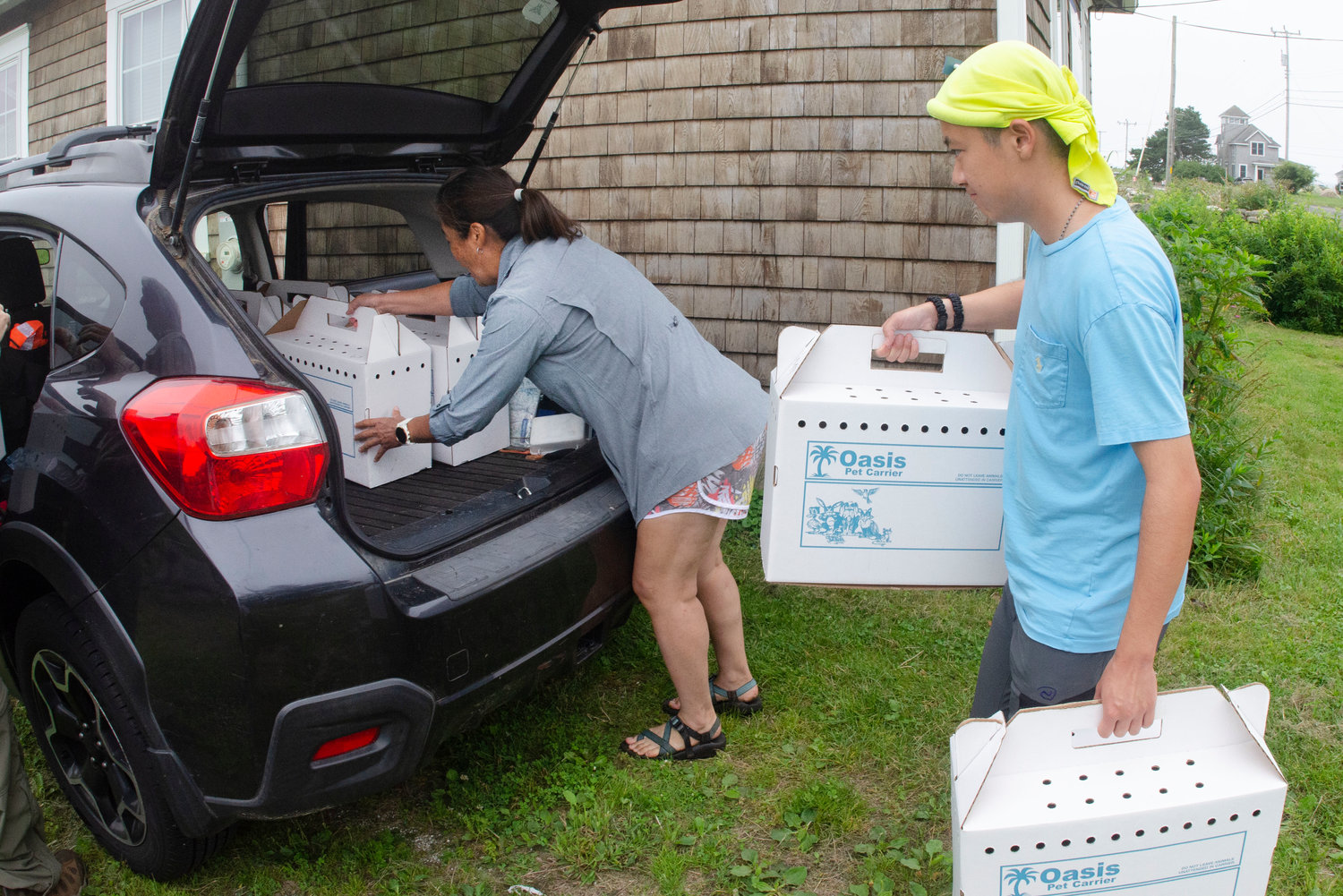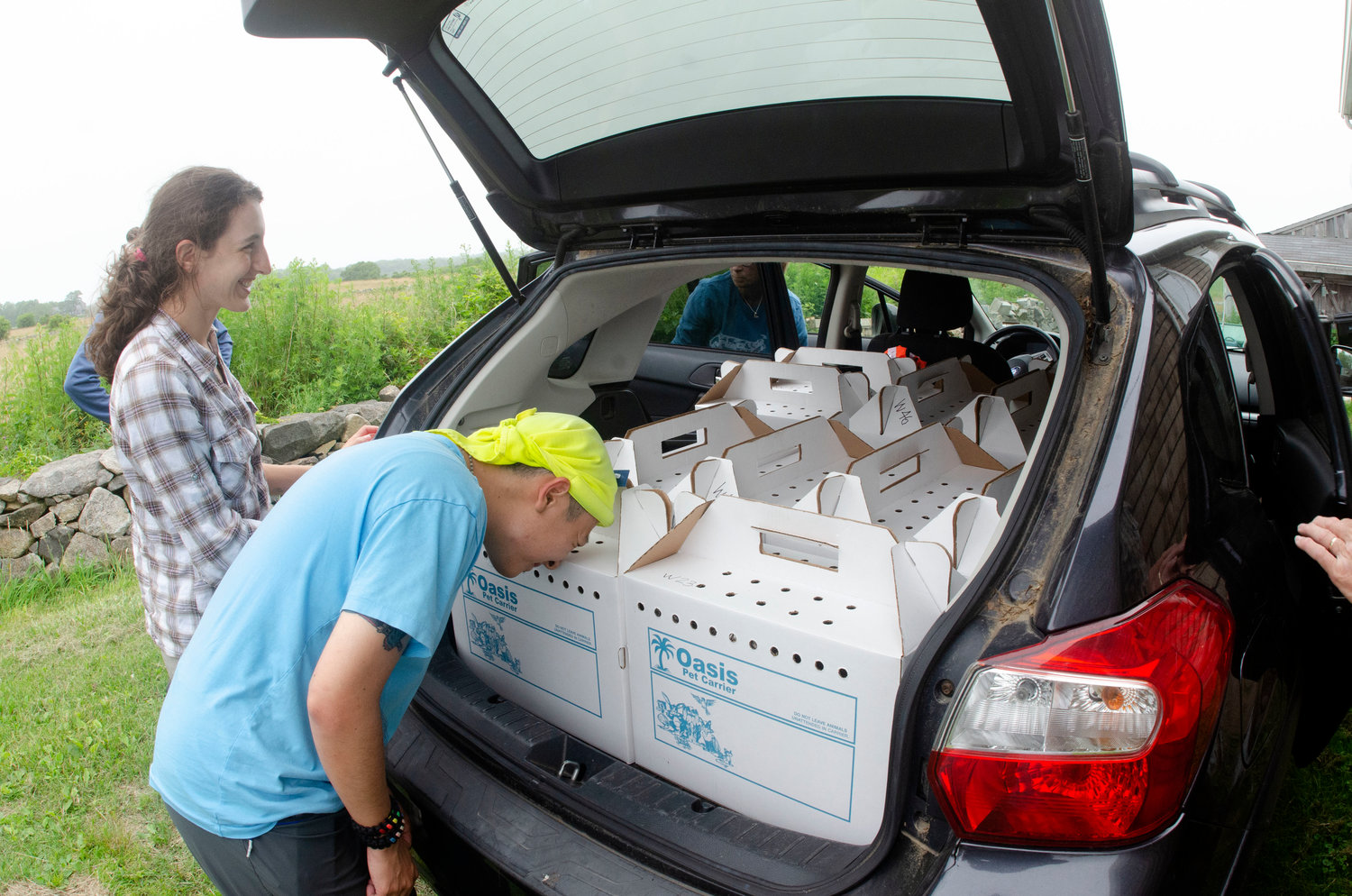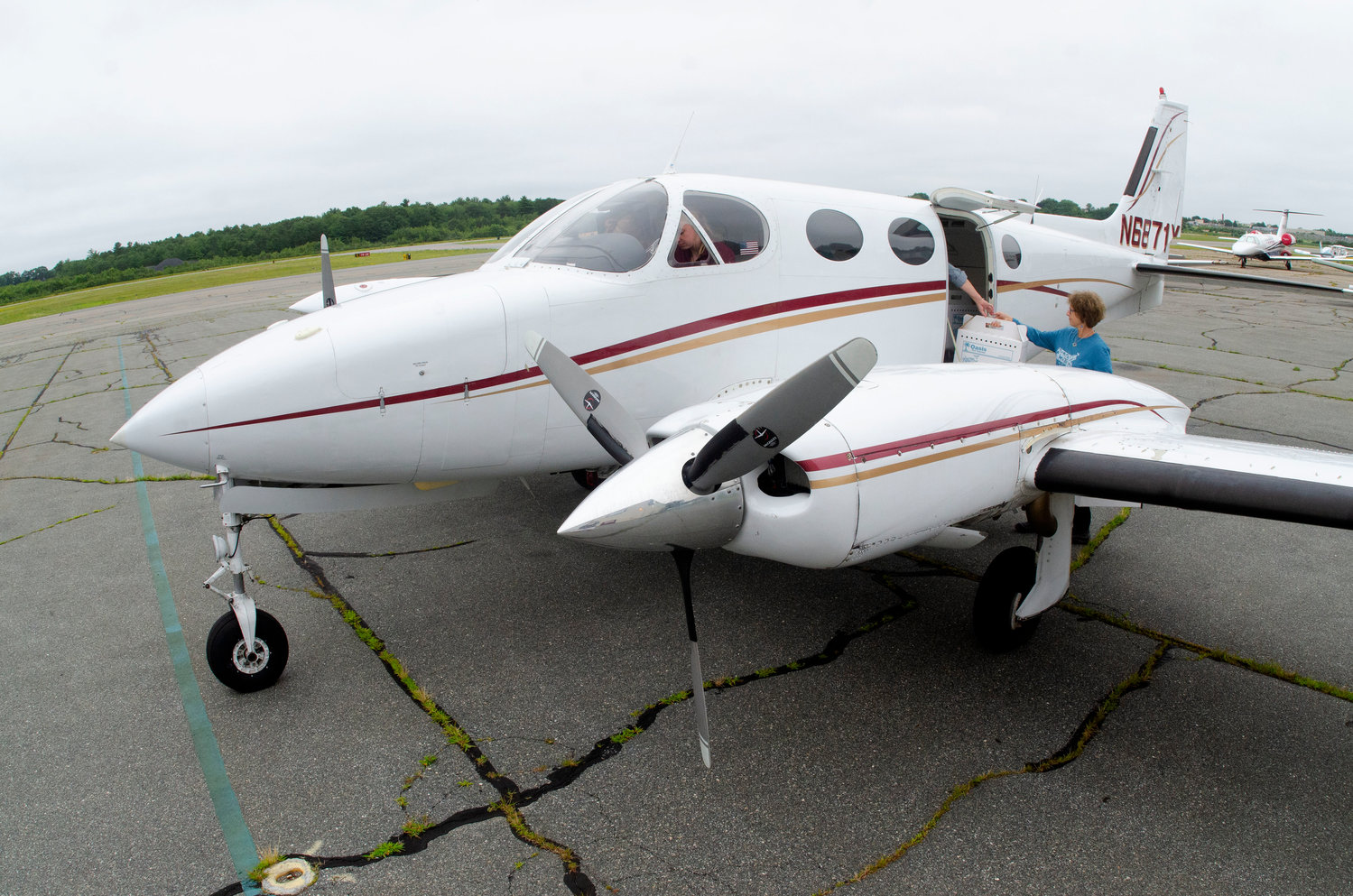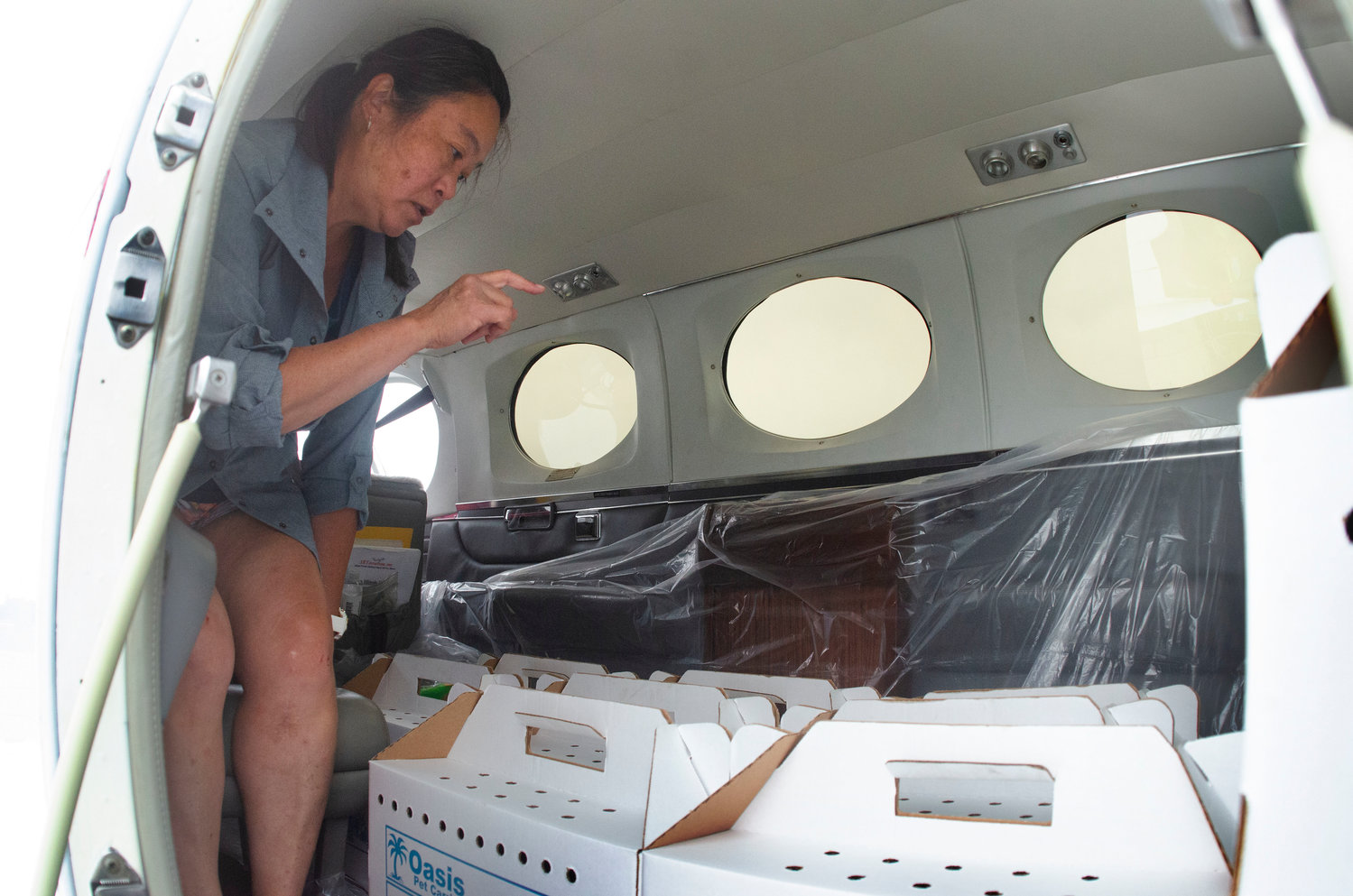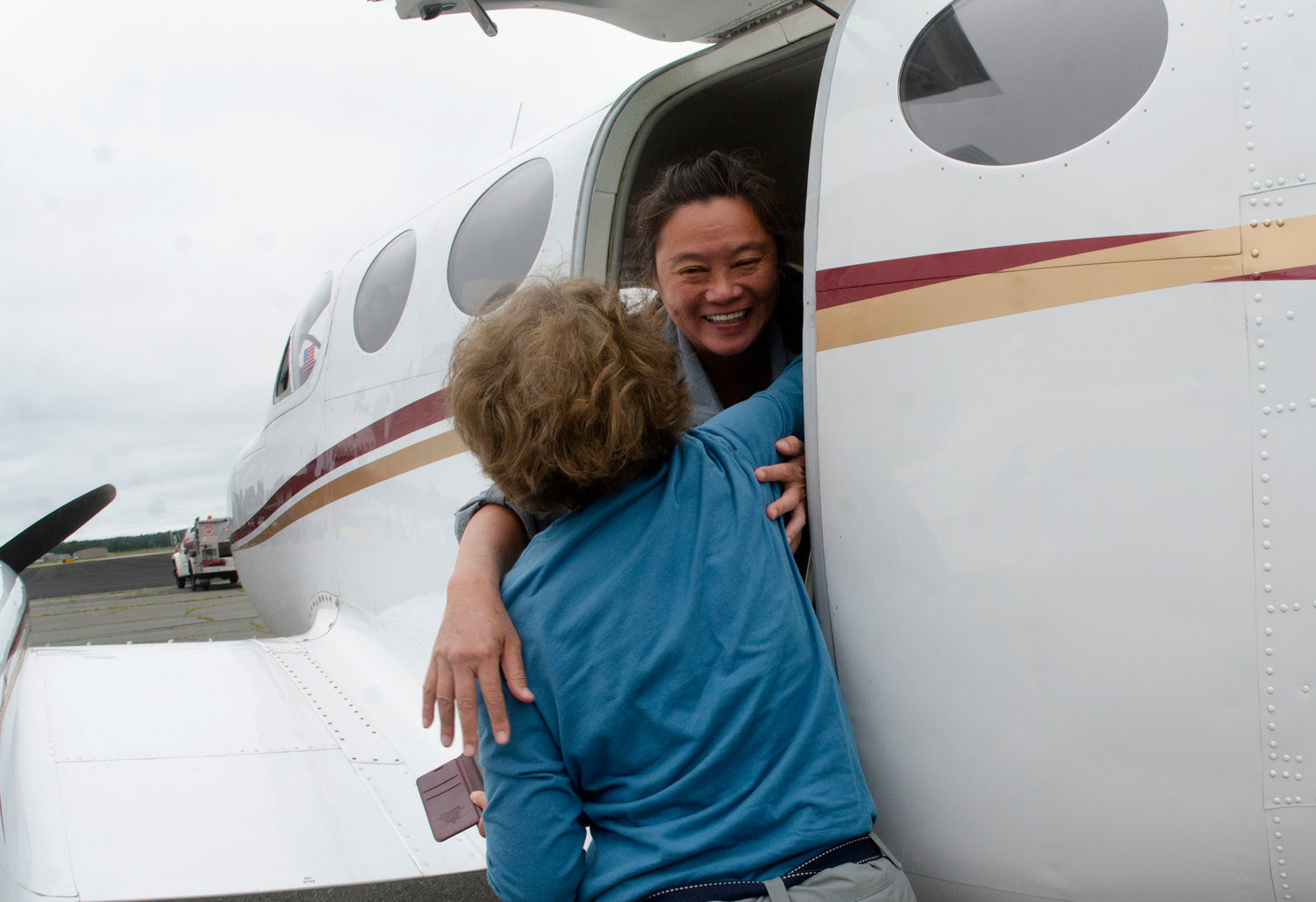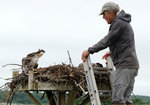- TUESDAY, JULY 16, 2024
Audubon and volunteers collect osprey for long journey to Illinois
Fledglings bound for restoration program in Illinois

Born on the Westport River, a dozen young osprey took flight recently — in a plane — and landed at their new home in Illinois. There it is hoped that they will help launch an osprey success story of the sort that has happened here over the decades.
Ten determined individuals including, Tih-Fen Ting, an ecology and environmental science instructor at the University of Illinois Springfield, Dr. Alan Poole, a retired ornithologist, Gina Purtell, Mass Audubon Southeast Program Manager for Community Science and Coastal Residence, Katelyn Depot, Mass Audubon osprey technician, two interns and four volunteers, set off on skiffs into the East and West Rivers in Westport to capture 12 fledglings for the state of Illinois Osprey Recovery Project on Tuesday morning, July 13.
“Osprey are a state-threaten species in Illinois,” said Ms. Ting as she prepared to embark on the Westport River. “So, I jumped at the opportunity to help establish self-sustaining, breeding, osprey populations in Central Illinois down the road.”
“Osprey have charisma,” said Ms. Ting. “Raptors are very popular. Once you actually get to watch their behaviors, I think this is one of the coolest things to do.”
“Working with the birds a whole season (three months), tracking them, getting to know them very well on a daily basis, past field technicians have expressed, that is was a rewarding and an amazing experience to work with the birds.”
Hacking for recovery
A number of midwestern states used hacking, the process of translocating chicks to bolster the status of their osprey population. The relocated chicks are placed in large enclosed “hack boxes” where they are provided fresh fish, water, and plenty of room to exercise their wings, said Ms. Ting.
“We have two hack towers for the osprey to come home to,” said Ms. Ting. “It is like a tree house built on a platform, 12 feet above the ground. That’s where we house the chicks.”
The osprey recovery project hack towers are located in West Central Illinois along the Illinois River and in East Central Illinois at 11,000-acre Lake Shelbyville, a man-made reservoir located in Shelby County and Moultrie County. The reservoir was created by damming the Kaskaskia River. “We pick the sites intended for the osprey to establish themselves in those general areas,” Ms. Ting said.
Once the raptors are at the hack tower, “We become their foster parents,” Ms. Ting said. “We collect the chicks at six weeks old. They are not ready to fledge, not yet able to fly. The birds usually fledge at about 7 to 8 weeks. Which means that they will be staying in the hack box for another two weeks before they are ready to fledge locally at our Illinois locations.”
During this time, Ms. Ting’s field technicians feed the fledglings twice a day and monitor their progress — whether they are eating, developing, and making sure they are in good health.
“Once they are ready to fledge, we start opening the bird door. When they are ready, they begin to fledge and hunt on their own. From then on, we track them to make sure that they are alive and doing well, until they embark on their first migration journey,” said Ms. Ting.
Diligent field technician
In 2013, Ms. Ting acquired grants from the US Fish and Wildlife Service and the Illinois Department of Natural Resources to start the osprey hacking program for the state of Illinois.
“For the first number of years, we were getting the chicks from Chesapeake Bay,” said Ms. Ting. “Since 2019, we have been getting the chicks from Westport and the Mass Audubon program.”
That became possible due to the diligence of Katelyn Depot.
Ms. Depot, a McGill University grad and wildlife biologist, is in her third year as an osprey program field technician with the Mass Audubon. She began volunteering in 2017, for then-Mass Audubon sanctuary director, Gina Purtell. In July of 2018, she took a paying job with Ms. Ting, to work as an osprey technician with the recovery program in Illinois.
“The Illinois project was having trouble finding chicks that were the correct age for their program,” Miss Depot said. Having worked there, “I knew that Westport had the densest osprey colonies in the world, so I suggested that they work with the Mass Audubon.”
“Katelyn rose to the occasion and exceeded all expectations,” said Mrs. Purtell. “She dove into the osprey program here then headed out to Illinois.” When she returned after the osprey season, Mrs. Purtell hired her back at Mass Audubon to head their osprey program.
In Illinois, the age of the chicks they were receiving from Chesapeake Bay was “off” and things didn’t go as well as hoped. “Their source population couldn’t provide the correct age of the chicks. One week off, either way, the chicks are either too young to feed themselves or too old that they will fledge too soon before they are acclimated. If they fledge too soon they won’t know where home is,” said Mrs. Purtell.
“Katelyn put me in touch with Gina and Dr. Alan Poole and it just happened,” said Ms. Ting. “It was great timing. It’s tremendous. I think that the Mass Audubon is running a wonderful program and certainly has helped make our job easier in Illinois. We know the conditions of the birds that we get and their exact age. I can’t say enough about how grateful we have been to those states who were willing to help us, monitor the chicks and then donate the chicks to us. We are lucky that Westport is able to spread their good fortune to other states.”
“The success at our site was driven by Gil and Jo Fernandez, who had taken chicks from the Chesapeake Bay in 1970 and built osprey platforms in the river,” said Mrs. Purtell. “We are paying it forward.”
The Fernandez started the project after the osprey population had perished from DDT, a synthetic organic compound used as an insecticide.
Hacking factors
Osprey must be an appropriate age and males are preferred for hacking, Miss Depot said. “Six weeks old, is the perfect age,” said Miss Depot. “At that age, they are hearty and old enough to be safely removed from their parents. They can keep themselves warm and eat fish that we give them.”
Older than six weeks can also be problematic. “We want them to be in the hack box long enough to know it’s their home, about one to two weeks before they are ready to fledge.”
At first the young osprey start to hang out on the roof of the hack box, said Miss Depot.
“Each day they begin to explore more and more and come back only to eat,” said Miss Depot. “The birds come back less and less as they learn how to hunt for themselves.”
The fledglings migrate in September down to Central America and Northern part of South America.
Male osprey tend to come back to the same area that they were fledged in,” said Dr. Alan Poole. “Males stay closer to home than females do. That is typical for most birds. Females are the wanderers. Males have what’s called natal dispersal. The distance that you disperse from your natal site.” “Males have a shorter natal dispersal distance on average, than females. But there are always some that bend the rules.”
“The hope is that the males will come back to Illinois with a female mate that they meet during migration,” said Miss Depot.
Which fledglings to take
“We take only one chick per nest and only nests that have multiple chicks,” said Miss Depot. “We have been monitoring the nests since early April. I knew how many chicks were in each nests and their age.”
“Technicians act as their foster parents. They ensure that they get all of the food and attention that they need. It’s a fresh water marsh as opposed to a salt water marsh. The osprey are really adaptable and can live on any water as long as there are fish,” Miss Depot said. “Normally the parents leave first and the chicks have to migrate on their own. That will not be any different in Illinois.”
On the River
Ms. Ting, Alan Poole and volunteers, Harold and Judy Isaksen opened a gate to a sheltered field at the end of Fisherville Lane in Westport, and navigated down a field to a remote dock on the East Branch of the Westport River. Mr. and Mrs. Isaksen handed Ms. Ting a pair of small cardboard boxes for the osprey as Mr. Poole put a ladder in the small three-seated boat and they set off.
Mr. and Mrs. Isaksen stayed behind, ready to collect the juvenile birds on their return.
Mr. Poole motored the skiff from an inlet to nests propped up on poles. As they approached the chosen nest, a startled adult sprang up, called out with a high-pitched whistle and soared off in hopes of luring the vessel away from the nest.
At high tide, Mr. Poole was able to nestle the skiff close to the roost. He threw out an anchor, grabbed the ladder and climbed up to find two juvenile osprey, a male and a female.
Ms. Ting wrested the male from the nest then carefully descended and gently placed the young osprey into the cardboard box.
At the next predetermined nest, Mr. Poole determined that the female was healthier, so they took it, instead.
Back at the dock, Mr. and Mrs. Isaksen exchanged the osprey boxes for two empty ones. They placed the boxed osprey in the shade, to keep the birds cool and calm. Ms. Ting and Mr. Poole went back out and secured two more juveniles.
On the West Branch, Ms. Purtell and Ms. Depot, two interns, Pit Wang and Chris Duff and volunteer, Dick Manchester set out toward the nests in two boats.
At one of the nests, Mrs. Purtell and Miss Depot did not find a defending adult. Out of three chicks that had been monitored, only one was left, alive.
“We found one juvenile osprey dead in the water,” said Mrs. Purtell. “One was missing and the one left alive, was unfed in the nest. We figured it was doomed.”
So they decided to take it as one of the 12 to go to Illinois. “This way it might have a fighting chance,” Mrs. Purtell said.
Once they captured the osprey, the ferry skiff would meet them, take the chicks and get them to locations on shore. The crew handed four chicks to volunteer Christina Glaser at her dock on River Road and brought four others to Pit Wang. One was dropped at a location down river and three more were dropped at Adamsville Landing.
Race to the airport
The teams now had to move fast to limit the time that the osprey were in their boxes. At Allens Pond Wildlife Sanctuary, the birds were transferred to Mrs. Purtell’s large SUV. She drove back roads to New Bedford Regional Airport. There, two pilots and the Cessna Skyhawk that Ms. Ting had secured, waited to fly the birds to Illinois. Ms. Purtell and Mr. Isaksen moved the osprey from the car to the plane where Ms. Ting placed them in a row in the back of the plane.
“All birds made the trip okay,” said Ms. Depot in a phone conversation three days later. “They all spent one night at the raptor center in Decatur, Illinois. The chicks ate a meal, had a health check up, then the next morning, they were placed in their hack boxes.”
In a text message with Ms. Ting a week later, she stated.
“The chicks are doing well inside the hack boxes,” said Ms. Ting. “They are not yet ready to fledge. All chicks have acclimated to the new environment and are eating a lot of fish, which is great. We would like them to eat well and to continue developing so that they’ll be ready to fledge before too long.”
Editor's note, Sept. 30, 2021: For more reading on this topic, see the following letters received in response to this article:
August 18: "Osprey relocation is barbaric and sad," by Carla Lindquist
Sept. 9: "There's more to the osprey story than recent removal," by David Cole
Sept. 18: "Westport osprey relocation will help here, and in Illinois," by Gina Purtell
Sept. 30: "David Cole's osprey letter was refreshing and kind," by Carla Lindquist
Other items that may interest you

